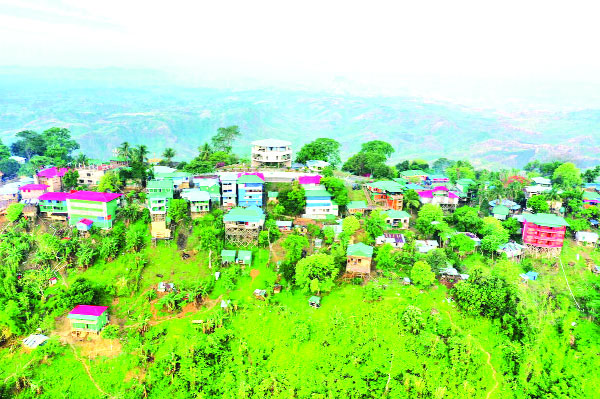Sajek Valley fetches annually
Tk 12,000 cr in tourism trade
Lokman Hossain: The picturesque Sajek Valley has become a popular domestic tourist haunt, gradually uplifting livelihood standards of local communities. At least Tk 12,000 crore trading been conducted in Sajek annually, which is a big boom of tourism sector of Bangladesh.
The valley, in Sajek union under Baghaichhari sub-district in Rangamati, lies in the hilly Kasalong range which is 67 kilometres north-east of Khagrachhari town and 95 kilometres off Rangamati.
Some 1,600 feet above sea level, Ruiluipara of Sajek union has become a tourist hotspot following establishment of road connectivity with Khagrachhari town, resorts and cottages, and tightened security.
Travel to the valley got popular following construction of a 67-kilometre road from Khagrachhari through hills on the way up to Ruiluipara by Engineer Construction Brigade (ECB) of Bangladesh Army.
After completion of the road in 2009 and tackling obstruction from local vested interests, tourism in Sajek started gaining pace since 2014.
Since late March of 2020, the valley was made off-limits like other domestic spots due to Covid-19. However, the ban was lifted in mid-September in 2021following slowed transmission rate.
Tourism in the Chattogram Hill Tract (CHT) has registered a rapid growth in recent years with improved road connectivity, improved accommodation and security.
Talking to the Daily Industry, Sajek Cottage Owners Association president Suporno Deb Barman said tourists in large numbers are revisiting since the reopening of Sajek as a boon for the locals.
Sajek has some 120 hotels, resorts and cottages with the daily accommodation capacity of 2,500-3,000 visitors every day.
“Some 3,000-3,500 tourists come to Sajek on weekends and 1,000-1,500 on other weekdays,” Barman said.
Indicating a good business since mid-October, he said more than 80 per cent of the rooms in popular cottages are booked until the end of January.
Accommodation facilities aside, there are over 150 restaurants, tea stalls, grocery shops, souvenir and handicraft stalls which are also doing a good trade for the past two months, he mentioned.
Khagrachhari deputy commissioner Pratap Chandra Biswas said 40-45 tourist buses come to the district every weekend to carry tourists who are destined for Sajek.
Communication with Sajek through Khagrachhari town is the easiest and shortest, he said, adding that tourism can be the driving force of local economy.
Apart from giving transit to Sajek, Biswas said, Khagrachhari district also has tourist attractions like Richang waterfall, Alutilla cave, Manikchari Mang Rajbari, Mahalchari Lake, Debota Purkur and Toiduchora.
With better socio-cultural harmony among Bangalee and hill tribes, he said, tourism in hill tracts can reach a new level.
Simple lifestyle and livelihood of hill ethnic communities, mainly Lushai, Pankhoa and Tripura, and their unique indigenous culture have become big attractions for tourists coming to Sajek valley.
Mentioning that a majority of ethnic communities living in Sajek for generations are poor, Ruiluipara headman Lal Thanga said most of the farming families can also earn from tourism now.
Many families are now earning through leasing land to resorts and cottages, taking jobs there and setting up different types of shops, he told the Daily Industry.
Citing unplanned construction, Thanga, however, said Ruiluipara has already been congested with establishments that obstruct beautiful views and also become vulnerable to landslide for the reason.
He suggested that the government make a plan to keep the natural beauty of Sajek intact by regulating construction of resorts and cottages.
Thanga also called for establishing a healthcare centre for local people and tourists while schools are also needed for tribal children.
Polen Tribura, a tea staller near Kanglakpara, said he now earns Tk 2,500-3,000 daily selling tea, biscuit, chips, fruits and drinking water to tourists.
The father of three now dreams to educate them so that they can make better livelihood than their ancestors.
“There was nothing 10 to 15 years ago. We had to travel a long way for daily commodities…,” he said, adding that tourism has created many jobs for local people.
Most popular resorts and cottages in Ruiluipara include the army-operated Sajek Resort and Runmoy Resort, SUMUI Eco Resort, Sajek Hill View Resort, Abakash Eco Cottage, Monghor Resort and Resort RungRang.
Others include Meghadree Eco Resort, Megh Machang Cottage, Megh punji Resort, Lushai Cottage and Rock Paradise Resort.
Most of these holiday resorts are situated within 2.5 kilometres from Ruiluipara to Kanglakpara.
A tourist needs to pay Tk 1,000-Tk 4,500 per night at these cottages while rent varies in terms of quality, service and seasonality.
Tourists prefer the cottages which are built facing the Lushai mountain range of the Indian state of Mizoram.
Rare Israeli airstrike in Beirut kills Hezbollah commander and more than a dozen others
International Desk: Israel launched a rare airstrike that killed a senior Hezbollah milita…








